
アフロ-カリビアン音楽
Afro-Caribbean music

☆ アフロ・カリビアン音楽(Afro-Caribbean music) は、カリブ海でアフリカン・ディアスポラから生まれた音楽スタイルを指す広義の言葉である。これらの音楽は通常、西アフリカや中央アフリカの影響を受けて いる。特徴的なのは、アフロ・カリビアン音楽には、アフリカの様々な文化や先住民、ヨーロッパの文化からの構成要素、楽器、影響が取り入れられていること である。 アフロ・カリビアン音楽は、歴史的、様式的な影響を受けてきた。歴史的には、アフロ・カリビアン音楽は大西洋横断奴隷貿易の影響を受けており、後に奴隷の 抵抗と解放の影響を受けている。スタイル的には、アフロ・カリビアン音楽は様々なアフリカ、ヨーロッパ、ラテンアメリカ先住民の影響を受けている 。 アフロ・カリビアン音楽は、伝統的なヨーロッパスタイルの音楽と多くの共通点を持ち、このジャンルの音楽では多くのヨーロッパの楽器、ハーモニー、メロ ディーを使用している。ラテンアメリカ先住民の影響は、打楽器や特定のボーカルテクニックの使用を通して見ることができる。アフロ・カリビアン音楽には、 ポリリズム、コールアンドレスポンス、様々な楽器の使用など、多くの共通の音楽的特徴がある。アフロカリビアン音楽でよく使われる楽器は、ドラム、打楽 器、ギターなどである。 アフロカリビアン音楽のルーツは15世紀まで遡るが、正式な地場産業として始まったのは1920年代である。アフロ・カリビアン音楽が人気を博すにつれ、 多くのサブジャンルが出現し始めた。これらのサブジャンルには、ソン・クバーノ、サルサ、カリプソ、ソカ、メント、スカ、レゲエ、メレンゲなどがある(→「カリブ海・カリブ海地方」)。
| Afro-Caribbean
music is a broad term for music styles originating in the Caribbean
from the African diaspora.[1] These types of music usually have West
African/Central African influence because of the presence and history
of African people and their descendants living in the Caribbean, as a
result of the trans-Atlantic slave trade.[2] These distinctive musical
art forms came about from the cultural mingling of African, Indigenous,
and European inhabitants. Characteristically, Afro-Caribbean music
incorporates components, instruments and influences from a variety of
African cultures, as well as Indigenous and European cultures.[3] Afro-Caribbean music has been influenced by historical and stylistic influences. Historically, Afro-Caribbean music was influenced by the transatlantic slave trade and later, by the resistance and emancipation of slaves.[4] Stylistically, afro-Caribbean music has been influenced by various African, European and Indigenous Latin American influences.[3] African influences are reflected by many of the Rhythms, vocal characteristics and instruments that are used in afro-Caribbean music.[3] Afro-Caribbean music shares many commonalities with traditional European style music, using many European instruments, harmonies and melodies in music of the genre.[3] Indigenous Latin American influence can be seen through the use of percussive instruments and certain vocal techniques.[5] Afro-Caribbean music has many common musical characteristics, including the use of Polyrhythms, call-and-response invocations and a variety of instruments. Instruments commonly used in afro-Caribbean music include: drums, Percussion instruments and Guitars. Although the roots of afro-Caribbean music go back to the 15th century, the official local industry only began in the 1920s.[6] Following this, afro-Caribbean music gained global popularity throughout the 20th century. [4] As afro-Caribbean music gained popularity, many sub-genres began to emerge. These sub-genres include: son cubano, salsa, calypso, soca, mento, ska, reggae and merengue.[4] |
アフロ・カリビアン音楽(Afro-Caribbean
music)は、カリブ海でアフリカン・ディアスポラから生
まれた音楽スタイルを指す広義の言葉である[1]。これらの音楽は通常、西アフリカや中央アフリカの影響を受けている。特徴的なのは、アフロ・カリビアン
音楽には、アフリカの様々な文化や先住民、ヨーロッパの文化からの構成要素、楽器、影響が取り入れられていることである[3]。 アフロ・カリビアン音楽は、歴史的、様式的な影響を受けてきた。歴史的には、アフロ・カリビアン音楽は大西洋横断奴隷貿易の影響を受けており、後に奴隷の 抵抗と解放の影響を受けている[4]。スタイル的には、アフロ・カリビアン音楽は様々なアフリカ、ヨーロッパ、ラテンアメリカ先住民の影響を受けている [3]。 [3]アフロ・カリビアン音楽は、伝統的なヨーロッパスタイルの音楽と多くの共通点を持ち、このジャンルの音楽では多くのヨーロッパの楽器、ハーモニー、 メロディーを使用している[3]。ラテンアメリカ先住民の影響は、打楽器や特定のボーカルテクニックの使用を通して見ることができる[5]。アフロ・カリ ビアン音楽には、ポリリズム、コールアンドレスポンス、様々な楽器の使用など、多くの共通の音楽的特徴がある。アフロカリビアン音楽でよく使われる楽器 は、ドラム、打楽器、ギターなどである。 アフロカリビアン音楽のルーツは15世紀まで遡るが、正式な地場産業として始まったのは1920年代である[6]。[4]アフロ・カリビアン音楽が人気を 博すにつれ、多くのサブジャンルが出現し始めた。これらのサブジャンルには、ソン・クバーノ、サルサ、カリプソ、ソカ、メント、スカ、レゲエ、メレンゲな どがある[4]。 |
| Development of the industry Local Caribbean 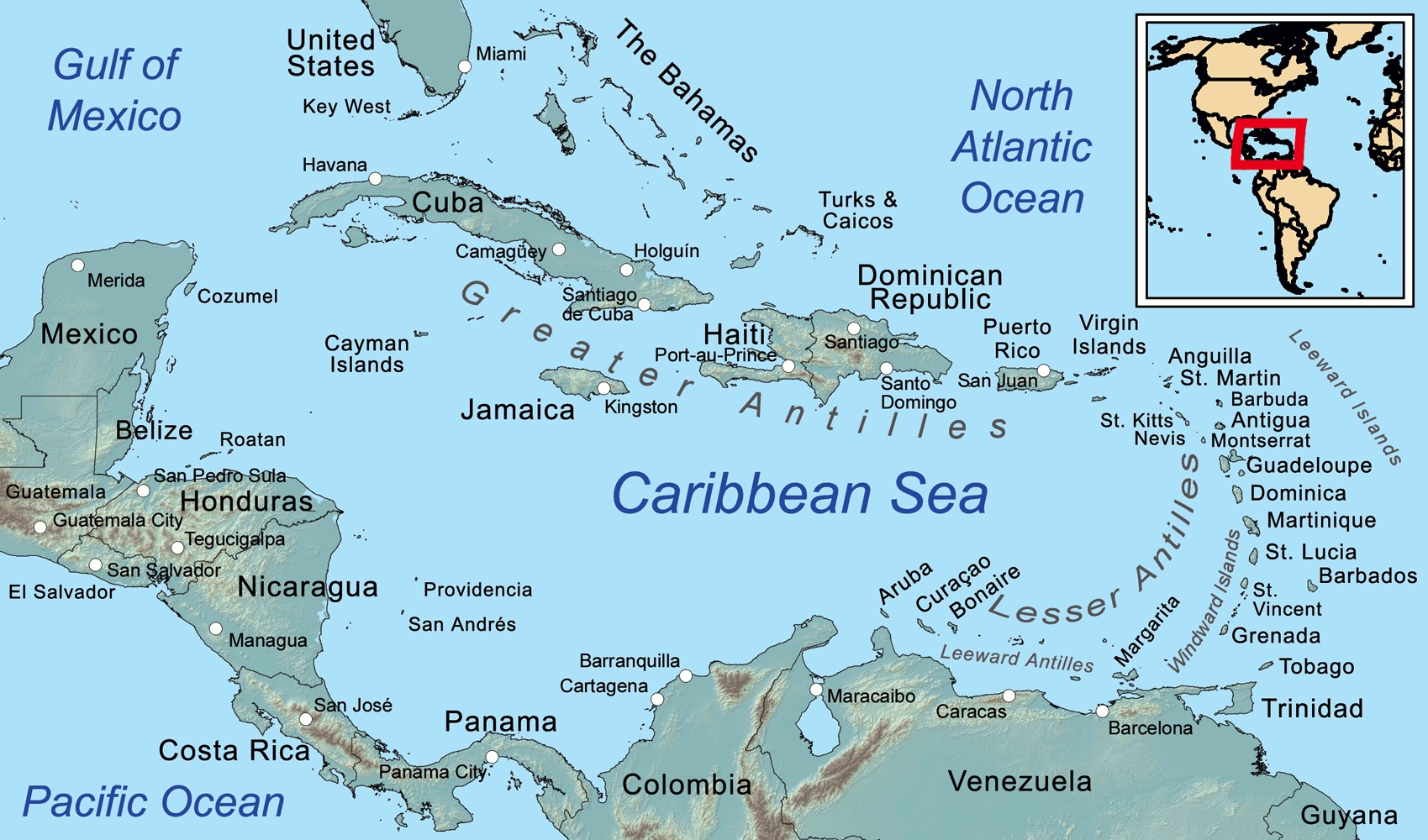 Map showing the Caribbean islands and sea in respect to the rest of the world. Afro-Caribbean music began in the Caribbean as a result of the transatlantic slave trade and the creation of a neo-African culture among slaves.[4] Afro-Caribbean music dates back as far as the 15th century, when the slave trade began.[7] Although afro-Caribbean music existed for centuries, local recording and distribution officially began in the 1920s.[6] Some of the earlier afro-Caribbean sub-genres to emerge included calypso, merengue, son, reggae and salsa.[6] Due to multiple problems with production and distribution, music from the region struggled initially to gain global popularity.[6] Global popularity Afro-Caribbean music rose to popularity during the 20th century, exerting influence over many subsequent genres including jazz and hip-hop.[4][1] Many of these sub-genres have been validated in recent years due to a newfound appreciation of afro-Caribbean culture and tradition.[1] In the United States, the genre has gained popularity due to the mass media infrastructure, large immigrant population and receptive non-Caribbean audiences.[1] Due to these factors, New York City, although not in the Caribbean, is considered another centre of afro-Caribbean music.[1] Sub-genres that gained popularity in the United States include the rumba, salsa and reggae.[1] These genres were particularly popular among youth during the 1970s in countries such as the United States and the United Kingdom.[1] |
音楽産業の発展 カリブ海地域  カリブ海の島々と海を、世界の他の地域と比較して示した地図。 アフロカリビアン音楽は、大西洋横断奴隷貿易と奴隷の間でのネオアフリカ文化の創造の結果としてカリブ海で始まった[4] 。 [カリプソ、メレンゲ、ソン、レゲエ、サルサなど[6]、アフロ・カリビアン音楽の初期のサブジャンルのいくつかは、カリプソ、メレンゲ、ソン、レゲエ、 サルサなどであった[6]。 世界的な人気 アフロ・カリビアン音楽は20世紀に人気を博し、ジャズやヒップホップなど、その後の多くのジャンルに影響を及ぼした[4][1]。 近年、アフロ・カリビアンの文化や伝統に対する新たな認識により、これらのサブジャンルの多くが検証されている[1]。 [1]これらの要因から、カリブ海諸国ではないが、ニューヨークはアフロ・カリビアン音楽のもう一つの中心地と考えられている[1]。アメリカで人気を博 したサブジャンルには、ルンバ、サルサ、レゲエなどがある[1]。 これらのジャンルは、アメリカやイギリスなどの国々で1970年代に若者の間で特に人気があった[1]。 |
| Influences of afro-Caribbean
music Historical influences Role of the transatlantic slave trade 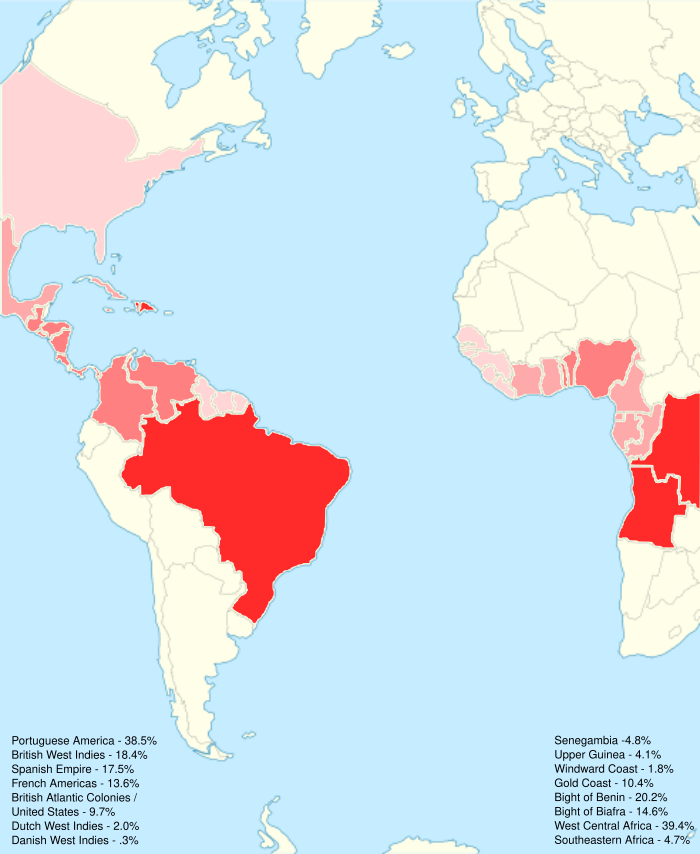 Map of the Atlantic Ocean depicting the regions of Africa where slaves were taken from and the regions of the Americas where they were sent to work. The origin of afro-Caribbean music traces back to the 15th century and the arrival of African people in the Caribbean via the transatlantic slave trade.[7] During the slave era, rivalling African villages attained captives who were sold into the slave trade.[8] The collaboration of African states with European slave traders stimulated the slave trade, eliminating the need for kidnapping or effort by the European slavers.[8] There were many different African cultures and traditions present among the Caribbean slave population.[4] Music, tradition and religion were important to African people.[4] As a result, neo-African cultures began to form among slaves from different parts of Africa, combining elements from a variety of African cultures.[4] The creation of a neo-African cultures among slaves allowed for the creation of new communities and the development of slave resistance.[4] Music was an important factor in the recreation of community among slaves, leading to the creation of afro-Caribbean music.[4] Role of emancipation The Haitian Revolution saw the end of slavery in Haiti at the end of the 18th century.[9] This effectively saw Haiti as the first nation in the world to abolish slavery.[10] Following the Haitian revolution, Britain concluded the importation of slaves in 1807 and began the process of abolition in 1823.[9] The abolition of slavery in Britain was said to be complete in 1838.[11] Although the slave trade was abolished in Britain in the early 19th century, the slave trade continued via the Iberian Peninsula until as late as 1873.[8][9] Due to this, approximately 135 000 slaves continued to be traded annually between 1800 and 1850.[8] The abolition of slavery restricted afro-Caribbean music in one way as it led to a decreased number of slaves arriving from Africa and a weakened link between African people living in the Caribbean and their homeland.[9] At the same time the abolition of slavery opened the door for previously enslaved Africans to participate more freely in music again, leading to further development of afro-Caribbean music.[9] Stylistic influences Afro-Caribbean music is characterised by the combined influence of African, European and indigenous Caribbean cultures.[3] African music Many rhythms, song styles and vocal characteristics used in afro-Caribbean music are reflective of traditional African music.[3] Examples of African vocal characteristics include call-and-response invocations and textually repetitious, simple lyrics.[3] Afro-Caribbean music places a strong emphasis on rhythm, or a series of repeated pulses, this is also reflective of the influence of African music.[5] Dominant African influences include those from the Bantu, Kongo, Fon and Yoruba peoples.[12] This is largely reflective of the fact that many slaves were from Western or Central Africa due to their proximity to the Atlantic seaboard.[12] European music 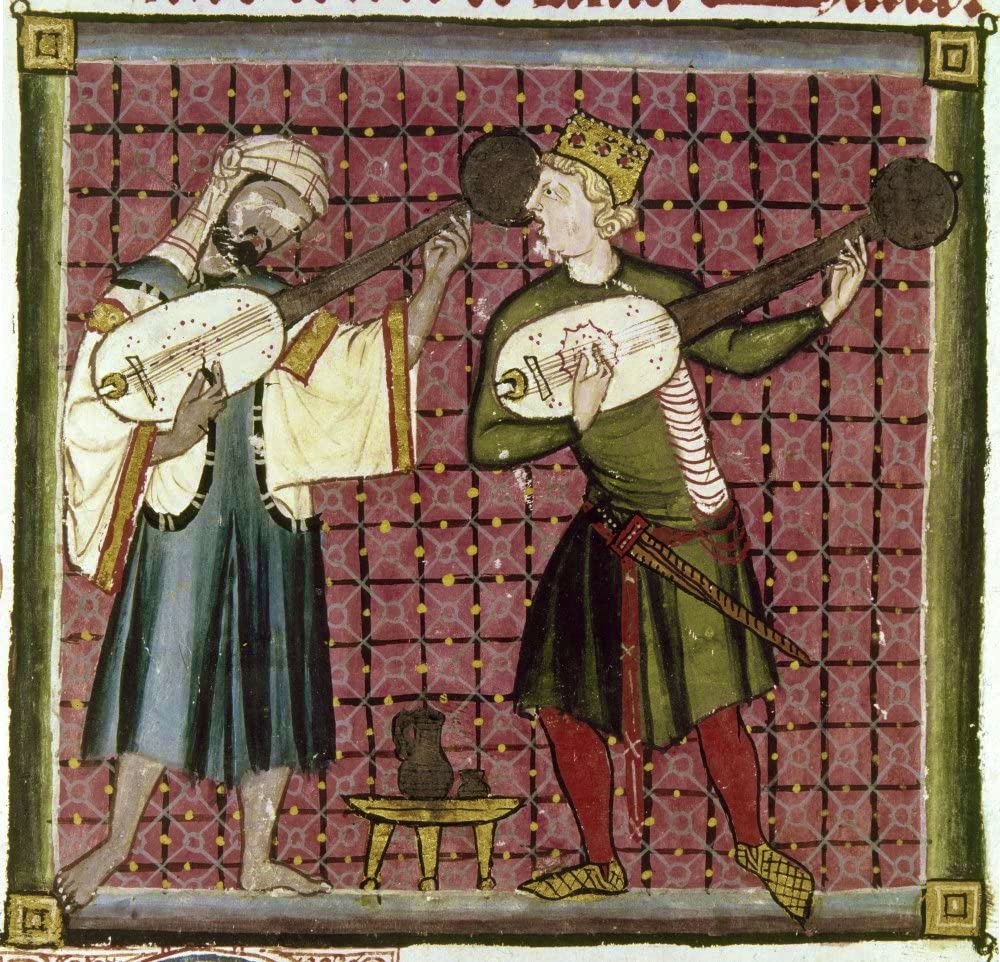 Painting from an anonymous artist in the 13th century depicting European musicians playing traditional string instruments. The European influence seen in afro-Caribbean music stems from music that was popular in the colonial era such as classical, folk and dance music.[5] Popular dance music at the time included the contradance and quadrille.[5] Elements of the contradance have been incorporated into afro-Caribbean sub-genres such as the Merengue.[1] Due to the large numbers of Spanish settlers compared to English settlers in Caribbean colonies, the European influence on afro-Caribbean music is more strongly Spanish.[5] Examples of European influence in afro-Caribbean music include the presence of tonal harmonies, melodies and instruments of European origin.[13] The lyrics of afro-Caribbean music are most commonly in European languages such as Spanish, English or French.[3] The presence of European instruments and elements in afro-Caribbean music is reflective of the European music that slaves were forced to play for their masters.[14] Over time, African elements, such as percussion and call-and-response invocations, were combined with traditional European elements.[14] This led to the creation of a new hybrid genre, afro-Caribbean music.[14] 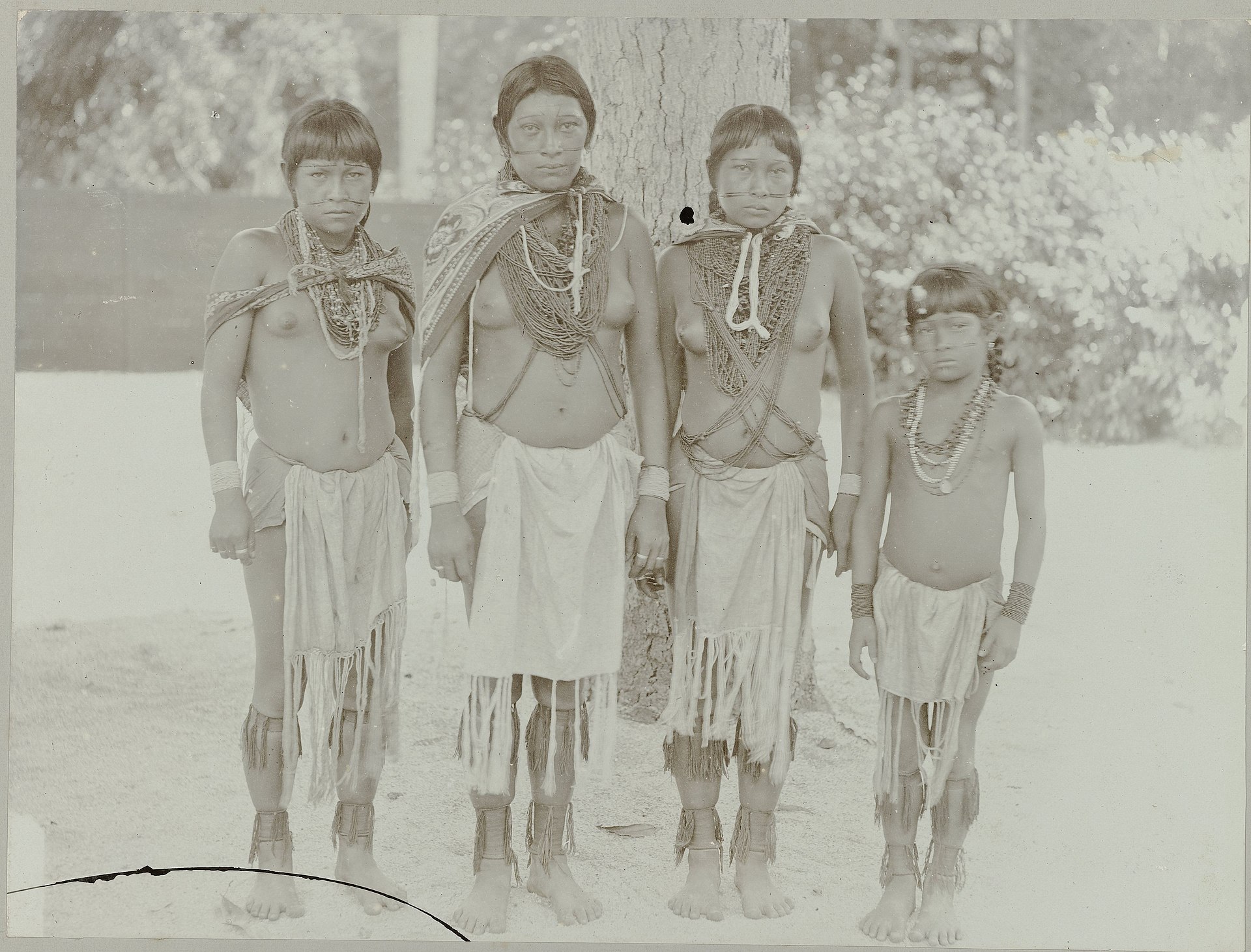 Four native Caribbean women from Suriname pose in the garden of the Government House in Paramaribo. ca.1850 Indigenous Caribbean and American music Afro-Caribbean music was influenced by the ceremonial-style, religious music of the native American people (including indigenous Caribbean people).[5] Traditional elements such as call-and-response style singing and the use of percussive instruments (such as Güiros and Maracas) are reflected in afro-Caribbean music.[5] |
アフロカリビアン音楽の影響 歴史的影響 大西洋横断奴隷貿易の役割  奴隷が連れ去られたアフリカの地域と、奴隷が働かされたアメリカ大陸の地域を描いた大西洋の地図。 アフロ・カリビアン音楽の起源は15世紀まで遡り、大西洋横断奴隷貿易を通じてカリブ海にアフリカの人々が到着したことに由来する[7]。奴隷時代には、 ライバル関係にあったアフリカの村々が奴隷貿易に売られる捕虜を獲得した[8]。 [音楽、伝統、宗教はアフリカの人々にとって重要であった[4]。その結果、アフリカの様々な地域から来た奴隷の間で、様々なアフリカ文化の要素を組み合 わせたネオ・アフリカ文化が形成され始めた[4]。奴隷の間でネオ・アフリカ文化が形成されたことで、新たなコミュニティが形成され、奴隷の抵抗が発展し た。 奴隷解放の役割 18世紀末、ハイチ革命によってハイチでは奴隷制度が廃止された[9]。 これによりハイチは事実上、世界で初めて奴隷制度を廃止した国となった[10]。 ハイチ革命後、イギリスは1807年に奴隷の輸入を停止し、1823年に奴隷廃止のプロセスを開始した。 [イギリスでは19世紀初頭に奴隷貿易が廃止されたが、イベリア半島を経由した奴隷貿易は1873年まで続いた。 [8][9]このため、1800年から1850年の間に年間約135,000人の奴隷が取引され続けた。奴隷制度の廃止は、アフリカから到着する奴隷の数 を減らし、カリブ海に住むアフリカの人々と祖国との結びつきを弱めることに繋がったため、ある意味でアフロ・カリビアン音楽を制限した[9]。 スタイルの影響 アフロ・カリビアン音楽は、アフリカ、ヨーロッパ、カリブ海の土着の文化の複合的な影響によって特徴付けられる[3]。 アフリカ音楽 アフリカのヴォーカルの特徴の例としては、コールアンドレスポンスによる呼びかけや、テキスト的に繰り返される単純な歌詞が挙げられる[3]。 [3]アフロ・カリビアン音楽はリズム、つまり一連の繰り返されるパルスに強い重点を置いているが、これもアフリカ音楽の影響を反映している[5]。アフ リカの影響としては、バントゥー、コンゴ、フォン、ヨルバ民族のものが支配的である[12]。これは、大西洋岸に近かったため、多くの奴隷が西部アフリカ や中央アフリカ出身であったことを大きく反映している[12]。 ヨーロッパの音楽  13世紀に描かれた、伝統的な弦楽器を演奏するヨーロッパの音楽家を描いた匿名の画家の作品。 アフロカリビアン音楽に見られるヨーロッパの影響は、クラシック、民族音楽、ダンスミュージックなど、植民地時代に流行していた音楽に由来する[5]。当 時流行していたダンスミュージックには、コントラダンスやクアドリルがあった[5]。コントラダンスの要素は、メレンゲなどのアフロカリビアン音楽のサブ ジャンルに取り入れられている[1]。 [5]アフロ・カリビアン音楽におけるヨーロッパの影響の例としては、ヨーロッパ由来の調性ハーモニー、メロディー、楽器の存在が挙げられる[13]。ア フロ・カリビアン音楽の歌詞は、スペイン語、英語、フランス語などのヨーロッパ言語で書かれていることがほとんどである。 [アフロ・カリビアン音楽におけるヨーロッパの楽器や要素の存在は、奴隷が主人のために演奏させられていたヨーロッパの音楽を反映している[14]。時を 経て、パーカッションやコールアンドレスポンスなどのアフリカの要素がヨーロッパの伝統的な要素と組み合わされた[14]。  パラマリボの政府庁舎の庭でポーズをとるスリナムの4人のカリブ先住民女性(1850年頃)。 カリブ海とアメリカの先住民音楽 アフロ・カリビアン音楽は、アメリカ先住民(カリブ海の先住民を含む)の儀式スタイルの宗教音楽の影響を受けている[5]。コール・アンド・レスポンスス タイルの歌唱や打楽器(ギュイロスやマラカスなど)の使用といった伝統的な要素は、アフロ・カリビアン音楽に反映されている[5]。 |
| Musical characteristics Components Replay Mute Captions More information Example of a polyrhythm. Polyrhythms The combination of multiple series of pulses is referred to as a polyrhythm.[15] These rhythms are often created using drums such as the batá.[16] This rhythm is used as a base, to which vocals and other instruments can be added to.[15] The Polyrhythm pattern is common in music derived from Western and Central Africa.[15] In afro-Caribbean music, the polyrhythm is mainly seen in the music derived from Cuba and Haiti.[15]  Example of musical notes for a call-and-response invocation. Call-and-response invocations Call-and-response invocations refer to a vocal technique where one phrase is sung by a member of the group and then it is answered by another member, who sings a complimentary phrase.[17] This technique was brought to the Caribbean by slaves that came from Western and Central Africa.[18] Call-and-response invocations are used throughout the afro-Caribbean music genre, and particularly in the music derived from Cuba.[3] Duration: 0 seconds.0:00 Example of a cinquillo rhythm. Cinquillo rhythm The cinquillo is a rhythmic pattern that is used in afro-Caribbean music.[18] This rhythmic cell originated in sub-Saharan Africa and was brought to the Caribbean by enslaved people of Bantu origin.[18] Once arriving in the Caribbean, the cinquillo beat was transformed and refined, in countries such as Haiti and Cuba, to fit the evolving afro-Caribbean music genre.[3] The cinquillo is created by use of percussion instruments such as the claves and güiro.[3] Instruments Drums 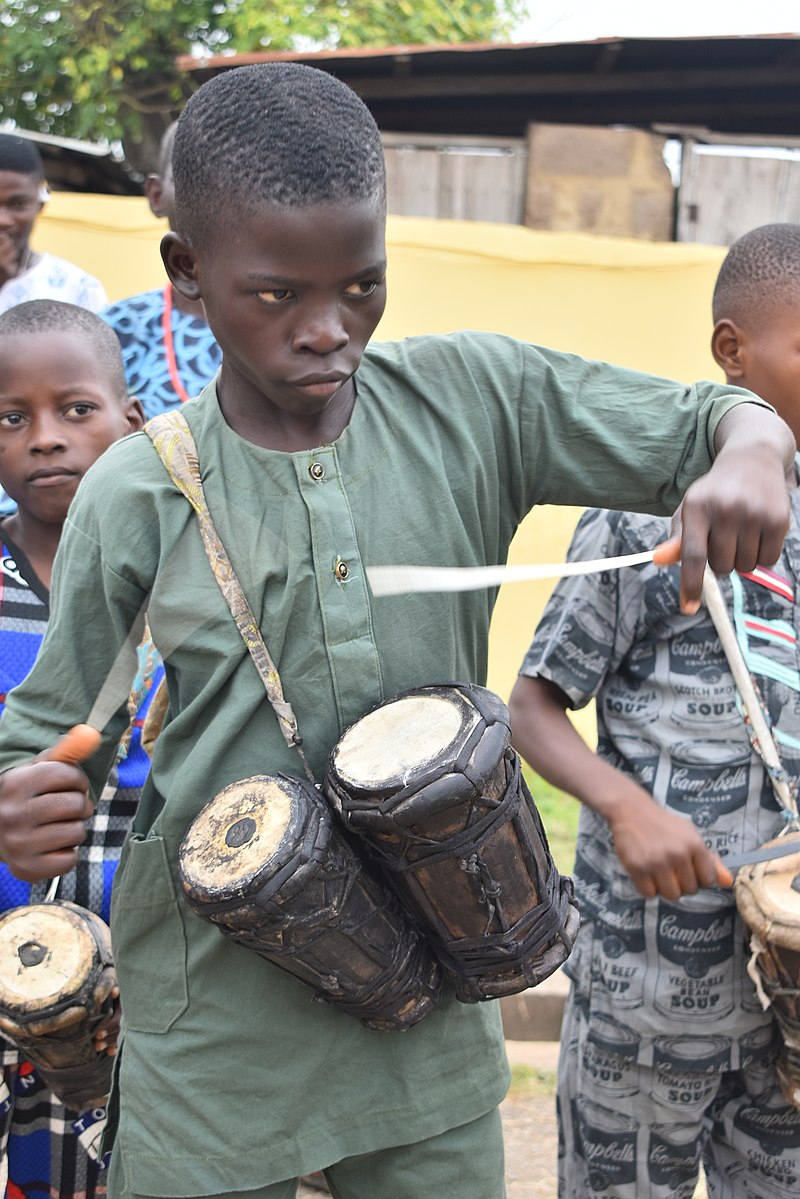 African child playing the batá drums. Drums are an important element of afro-Caribbean music, culture and religion.[19] Drums are used in many Rituals and ceremonies such as the Haitian vodun ceremony.[1] During the slave era, this strong link of drums with culture, religion and solidarity was recognised by white oppressors and drumming was subsequently banned in an attempt to curtail potential rebellions.[14] Congas, bongos, bombo and batá drums are most commonly heard in afro-Caribbean music, however, many other variations of drums are also used including the tumba francesa, palo, yuka and makuta drums.[16] The influence of the drums in afro-Caribbean music is mixed with many popular drum varieties originating in Latin America, Europe and Africa.[16] In most circumstances the roots of these drum types lead back to African origin.[16] A prominent drumming influence from Africa is the use of the hands to create music over a variety of Timbres, unlike in European music, where sticks are favoured to strike the drums.[16] Batá Main article: batá drum 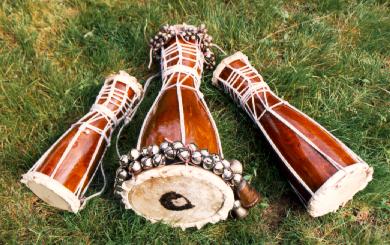 Three types of batá drums (from left: Okónkolo, Iyá, Itótele). Batá drums have an hourglass shape with a drumhead at either end.[20] Traditionally, a batá drum would consist of a wooden base with drumheads made of skin, pulled taut, at each end.[20]Batá drums are available in a variety of sizes, each with a different purpose in creating overall rhythm and sound.[20] Sound is produced by the individual striking the drumheads on each side with their hands.[20] This particular variety of drum originated in Nigeria among the Yoruba people and was once an instrument used for religious purposes to worship the African Orishas.[20] The batá drums are now widely used in Latin American and afro-Caribbean music.[21] Bombo Main article: bombo drum The bombo drum (also known as the bombo criollo) is another drum commonly seen in afro-Caribbean music. This drum is of South American origin and is commonly used in indigenous music of the region.[21] The bombo drum is composed of a large, hollow wooden drum with an animal skin for the drumhead.[21] Sound is produced on the bombo drum by striking the middle of the drumhead with the hand and by striking the rim of the drumhead with a small stick or other tool.[21] Congas and bongos 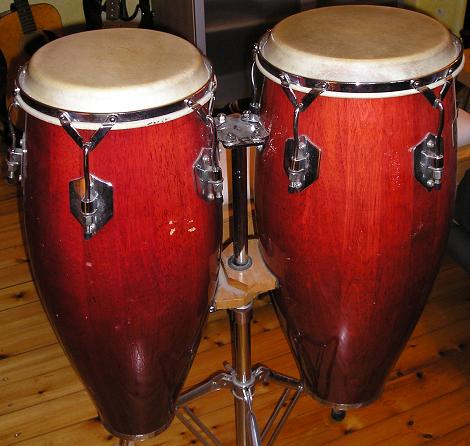 Pair of conga drums. Main articles: Conga drum, bongo drum Congas are tall, barrel-like, single-headed drums, usually played using the hands.[22] Bongos are similar to congas in shape, however, they are smaller and commonly played in pairs.[22] Bongos are tapered, single headed drums that are usually composed of a wooden base with an animal hide drumhead.[23] There are two variations of bongo drums that produce different pitches.[23] The macho bongo produces a high pitch, popping like sound and is referred to as the male bongo.[23] In contrast, the hembra bongo is considered the female of the pair and produces low, deep sounds.[23] The congas and bongos originated in Cuba among African slaves and are key instruments of the afro-Caribbean music genre.[23] These drums are reminiscent of other African style drums that inspired them such as the batá, yuka and makuta drums.[23] Hand-held percussion 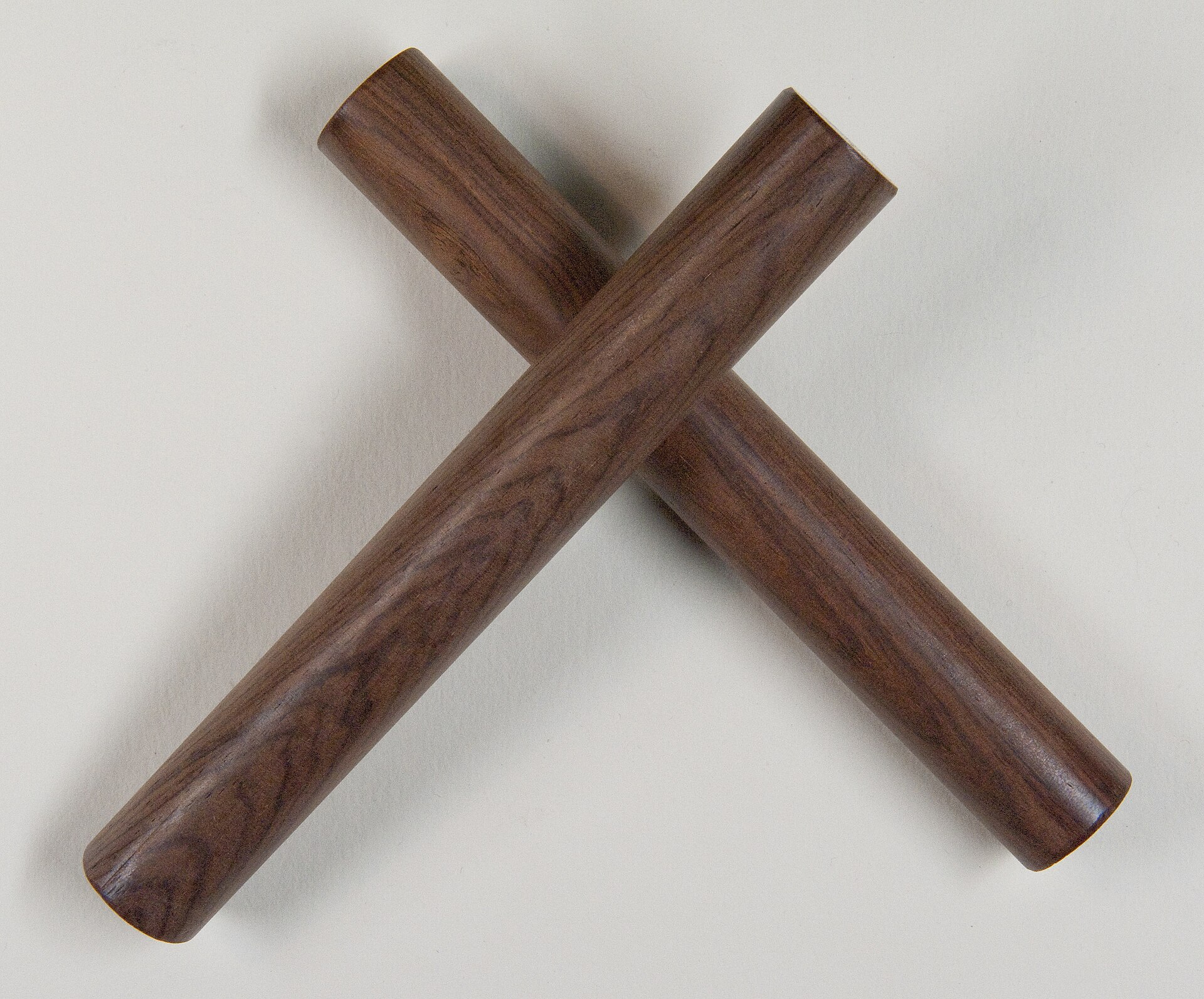 Wooden claves. Claves Main article: claves Claves (also called palitos) consist of two short, round pieces of wood which are struck together to produce sound.[18] Modern day claves originated in Cuba[18] and are reminiscent of early percussive instruments present in ancient, indigenous civilisations all around the world, including Africa and South America.[24][18] Claves are used to maintain a rhythm known as the ‘clave’, or the key.[25] Maracas 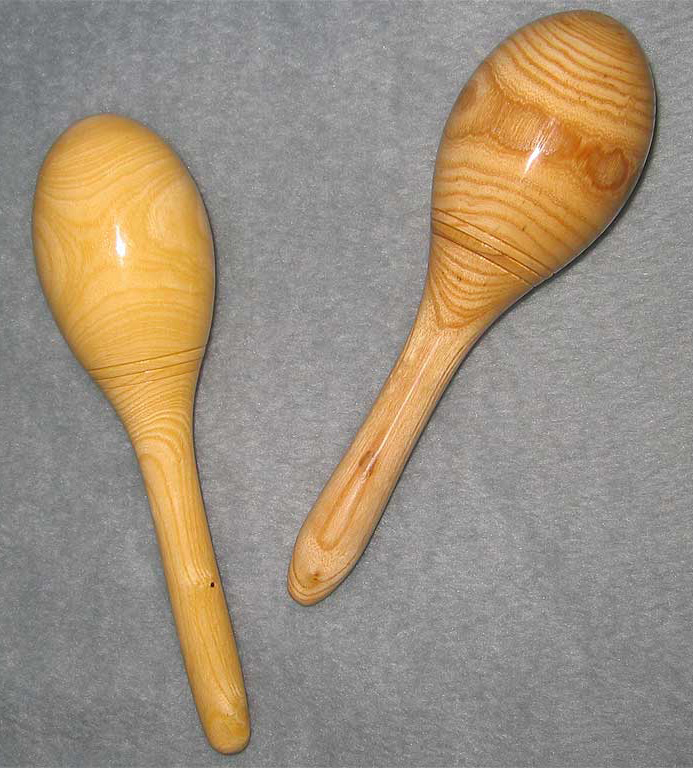 Maracas. Main article: Maracas Maracas (also called boîte à de clous, caraxa, mussamba) are handheld rattles consisting of a hollow vessel (such as a Gourds or Turtle shells), filled with small items (such as Seeds, nuts or shells), attached to a handle.[26][27] The Maraca is shaken to produce a rattle sound which is used to maintain tempo and rhythm.[26] Different versions of maracas originated in South America and Africa.[26][27] They were often played to accompany dancers and other musicians.[26] Variations of maracas include versions that are worn on the wrist and versions in different shapes of sticks, hourglasses, cones or crosses.[26] Maracas are used in many afro-Caribbean music genres including calypso, salsa and Son cubano.[27] Cabasa 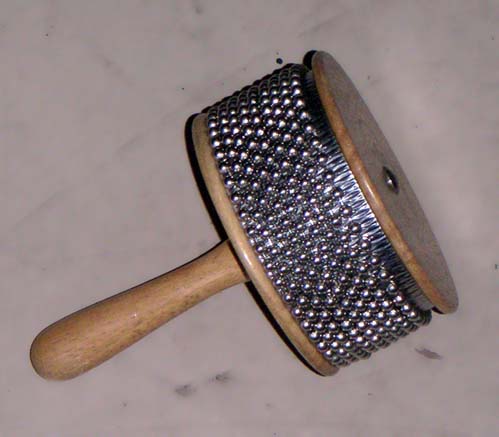 Cabasa. Main article: cabasa The cabasa (also called afuche, afoxê, cabaça, cabazam, cockolo) consists of steel balls that are looped around a hollow base.[28] The balls are then struck by hand to produce a rattling sound.[28] This percussion instrument has African Origin but is also found in Latin American musical history.[28] Güiro 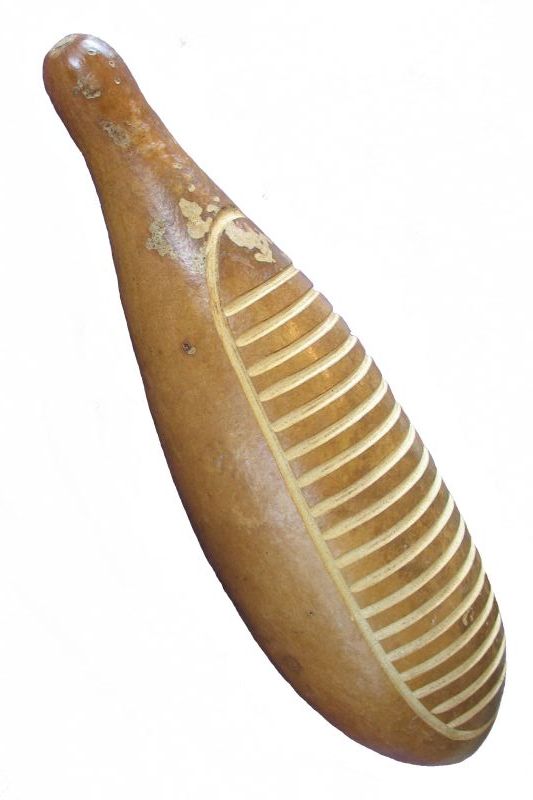 35cm long güiro from Cuba. Main article: güiro The güiro (also called lero-lero, rape de bois, querēquezé, reposing tiger, reco-reco) is a form of scraper instrument, consisting of the body of the instrument – a cylindrical, hollowed out piece of wood with several notches on one side – and a scraping implement such as a stick or piece of wood.[18][28] Rubbing of the scraping implement down the notches produces a ‘reco-reco’ sound.[28] The ‘reco-reco’ sound produced gives this instrument one of its many other names, the ‘reco-reco’.[28] The güiro is used, in conjunction with other percussive instruments, to maintain rhythm in afro-Caribbean music.[18] Agogô 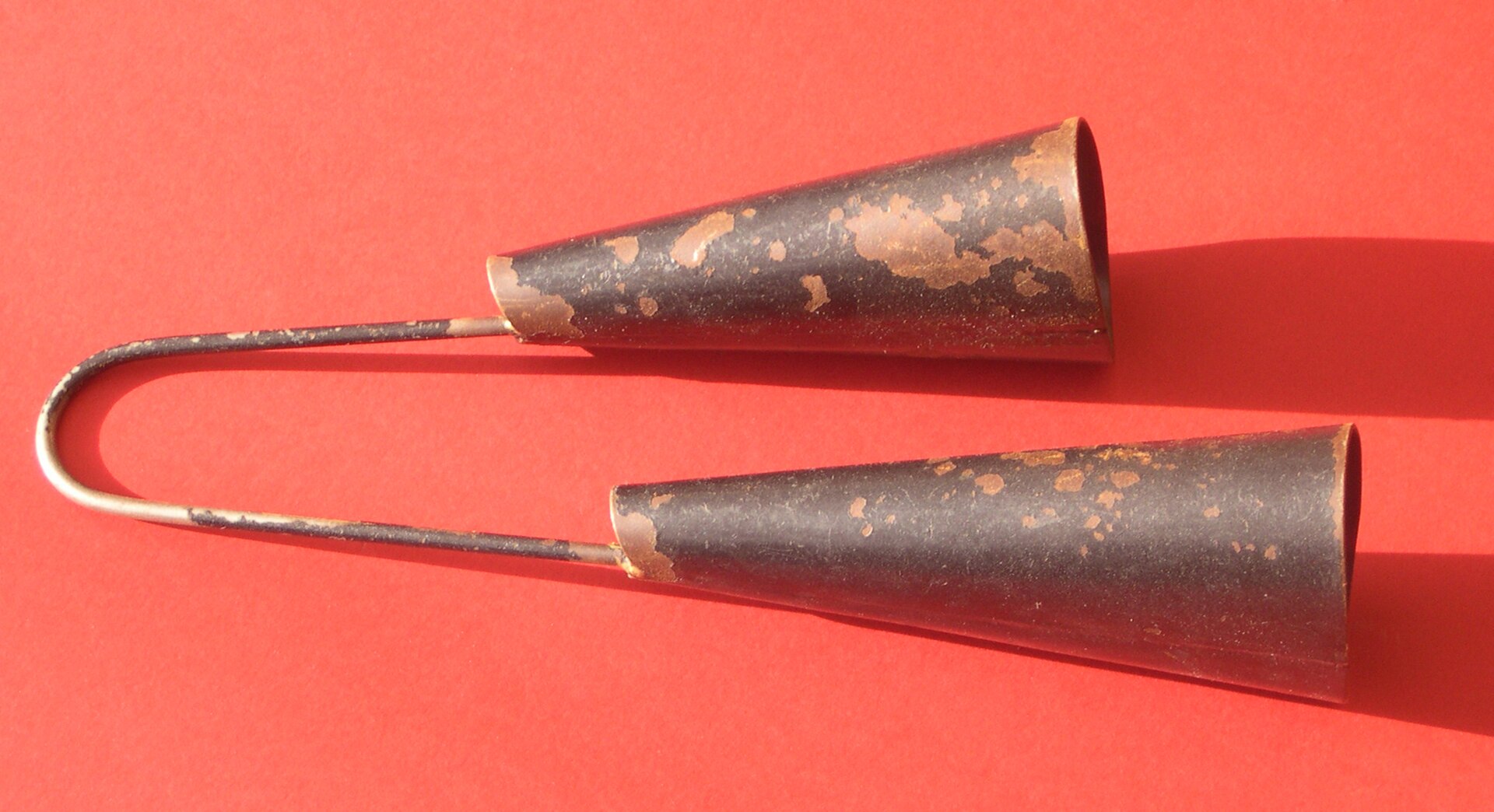 Agogo bell. Main article: agogô The Agogô (also called ga, gankogui, gongue) is a variety of bell used in afro-Caribbean music, they can include single, double or multi-headed bells that are attached to a metal handle.[29] The bells consist of a hollow, conical shaped item that jingles when shaken or struck.[29] Agogô bells are of Western African origin but are now also used in Brazilian and Latin American music.[29] Guitars The use of Guitars in afro-Caribbean music is reminiscent of European influence.[14] The guitars most commonly used in afro-Caribbean music include the guitarrone, the tres and the cuatro.[30] These regional varieties of guitars are based on classic European guitars such as the Spanish vihuela.[18] Guitarrón Main article: guitarrón The guitarrón (also known as guitarrone) is a large form of acoustic guitar.[18] It is a bass stringed instrument consisting of a wooden body, sound board and six plastic or metal strings.[18] Tres Main article: tres The tres is a small guitar consisting of a wooden body with three sets of double strings.[30][18] The tres originated in Cuba and is the national string instrument.[18] This variety of guitar was derived from similar instruments of both Spanish and indigenous African origin.[18] It is a component of many afro-Caribbean music genres including changüí, Sucu Sucu, salsa and guaracha.[18] Cuatro The cuatro is a small, Spanish-derived guitar consisting of a wooden body and four strings.[18] The cuatro acts as an accent to the bass notes of the guitar, providing syncopation.[18] Variants of the cuatro, such as the Venezuelan cuatro and the Puerto Rican cuatro, are common throughout the Caribbean.[18] The Venezuelan and Puerto Rican Cuatros are each national instruments of their respective countries.[18] The cuatro guitar is a component of afro-Caribbean subgenres such as calypso.[18] |
音楽的特徴 コンポーネント リプレイ ミュート 字幕 詳細情報 ポリ リズムの例(リンク) ポリリズム 複数の一連のパルスの組み合わせは、ポリリズムと呼ばれる[15]。これらのリズムは、バタなどのドラムを使って作られることが多い[16]。このリズム をベースにして、ボーカルや他の楽器を加えることができる[15]。ポリリズムのパターンは、西アフリカや中央アフリカに由来する音楽によく見られる [15]。アフロ・カリビアン音楽では、ポリリズムは主にキューバやハイチに由来する音楽に見られる[15]。  コールアンドレスポンスの音符の例。 コールアンドレスポンス コール・アンド・レスポンスの呼びかけは、グループのメンバーが1つのフレーズを歌い、それに答える別のメンバーが補完的なフレーズを歌うというボーカル 技法を指す[17]。この技法は、西アフリカや中央アフリカからやってきた奴隷によってカリブ海にもたらされた[18]。コール・アンド・レスポンスの呼 びかけは、アフロ・カリビアン音楽のジャンル全体、特にキューバに由来する音楽で使用されている[3]。 再生時間 0秒.0:00 チンキージョ・リズムの例 チンキージョのリズム チンキージョはアフロ・カリビアン音楽で使われるリズムパターンである[18]。このリズムの細胞はサハラ以南のアフリカで生まれ、バントゥー系の奴隷に された人々によってカリブ海にもたらされた。 [18]カリブ海に到着すると、ハイチやキューバなどの国々で、進化するアフロ・カリビアン音楽のジャンルに合うようにチンキージョのビートが変化し、洗 練された。チンキージョは、クラベスやグイロなどの打楽器を使用することによって生み出される[3]。 使用楽器 ドラム  バタ・ドラムを演奏するアフリカの子供。 ドラムはアフロ・カリビアン音楽、文化、宗教の重要な要素である[19]。ドラムはハイチのヴォドゥン儀式など多くの儀式やセレモニーで使用される [1]。奴隷時代には、ドラムと文化、宗教、連帯との強い結びつきが白人の抑圧者に認識され、その後、潜在的な反乱を抑制するためにドラム演奏が禁止され た[14]。 コンガ、ボンゴ、ボンボ、バタドラムはアフロカリビアン音楽で最もよく聴かれるが、トゥンバ・フランセーサ、パロ、ユカ、マクタドラムなど、他の多くのバ リエーションのドラムも使用されている[16]。アフロカリビアン音楽におけるドラムの影響は、ラテンアメリカ、ヨーロッパ、アフリカで生まれた多くのポ ピュラーなドラムの種類と混ざり合っている。 [16]ほとんどの場合、これらのドラム・タイプのルーツはアフリカに遡る[16]。アフリカからの顕著なドラムの影響は、ドラムを叩くためにスティック が好まれるヨーロッパ音楽とは異なり、様々なティンブルの上で音楽を作り出すために手を使うことである[16]。 バタ 主な記事:バタ・ドラム  3種類のバタ・ドラム(左からオコンコロ、イヤー、イトテレ)。 バタ・ドラムは砂時計のような形をしており、両端にドラムヘッドがある[20]。伝統的に、バタ・ドラムは木製の土台と、両端に張った皮でできたドラム ヘッドからなる[20]。 [20]音は、各人が両側のドラムヘッドを手で叩くことによって生み出される。[20]この特定の種類のドラムは、ナイジェリアのヨルバ族の間で生まれた ものであり、かつてはアフリカのオリシャを崇拝する宗教的な目的のために使用された楽器であった[20]。 ボンボ 主な記事:ボンボ・ドラム ボンボ・ドラム(ボンボ・クリオーリョとしても知られる)は、アフロ・カリビアン音楽でよく見られるもう一つのドラムである。このドラムは南米起源で、こ の地域の先住民族の音楽でよく使用されている[21]。ボンボ・ドラムは、ドラムヘッドに動物の皮を使用した、大きな中空の木製ドラムで構成されている [21]。 コンガとボンゴ  コンガ・ドラムのペア。 主な記事 コンガ・ドラム、ボンゴ・ドラム コンガは背の高い、樽のような、シングルヘッドのドラムで、通常は手を使って演奏する[22]。ボンゴはコンガと形状が似ているが、より小さく、通常はペ アで演奏する[22]。 [23]マッチョ・ボンゴは高音で破裂音のような音を出し、オス・ボンゴと呼ばれる[23]。対照的に、ヘムブラ・ボンゴはペアのメスとされ、低く深い音 を出す[23]。コンガとボンゴはキューバでアフリカ人奴隷の間で生まれたもので、アフロ・カリビアン音楽ジャンルの重要な楽器である[23]。これらの ドラムは、バタ、ユカ、マクタ・ドラムなど、彼らにインスピレーションを与えた他のアフリカン・スタイルのドラムを彷彿とさせる[23]。 ハンドヘルド・パーカッション  木製のクラベス。 クラベス 主な記事:クラベス クラベス(パリトスとも呼ばれる)は2つの短くて丸い木片で構成されており、それらを打ち合わせることで音を出す[18]。現代のクラベスはキューバで生 まれたものであり[18]、アフリカや南米を含む世界中の古代土着文明に存在した初期の打楽器を彷彿とさせる[24][18]。 マラカス  マラカス。 主な記事 マラカス マラカス(boîte à de clous、caraxa、mussambaとも呼ばれる)は、中空の容器(ひょうたんや亀の甲羅など)に小物(種、木の実、貝殻など)を詰め、取っ手に 取り付けた手持ちのガラガラである[26][27]。 マラカを振ってガラガラと音を出し、テンポやリズムを維持するために使われる。 [マラカスは、カリプソ、サルサ、ソン・クバーノなど、多くのアフロ・カリビアン音楽のジャンルで使用されている[27]。 カバサ  カバサ。 主な記事:カバサ カバサ(afuche、afoxê、cabaça、cabazam、cockoloとも呼ばれる)は、中空の台座の周りに輪になった鉄球から成る [28]。 グイロ  キューバの長さ35cmのグイロ。 主な記事:グイロ グイロ(lero-lero、rape de bois、querēquezé、reposing tiger、reco-recoとも呼ばれる)はスクレーパー楽器の一種であり、楽器の本体(片側にいくつかの切り込みがある円筒形のくり抜かれた木片) と棒や木片のような擦る道具で構成される。 [18][28]擦過具を切り欠きの下で擦ると「レコレコ」という音が出る[28]。この「レコレコ」という音から、この楽器には「レコレコ」という別名 がある[28]。グイロは、アフロ・カリビアン音楽においてリズムを維持するために、他の打楽器とともに用いられる[18]。 アゴーゴ  アゴーゴのベル。 主な記事:アゴーゴ アゴーゴ(ガ、ガンコグイ、ゴングとも呼ばれる)は、アフロ・カリビアン音楽で使用される様々なベルであり、金属のハンドルに取り付けられたシングル、ダ ブル、マルチヘッドのベルがある[29]。アゴーゴのベルは中空の円錐形のものから成り、振ったり叩いたりするとジャラジャラと鳴る[29]。 ギター アフロ・カリビアン音楽におけるギターの使用は、ヨーロッパの影響を彷彿とさせる[14]。アフロ・カリビアン音楽で最も一般的に使用されるギターには、 ギタロン、トレス、クアトロがある[30]。これらの地域的な種類のギターは、スペインのヴィウエラ[18]のような古典的なヨーロッパのギターに基づい ている。 ギタロン 主な記事:ギタロン ギタロン(ギタローネとも呼ばれる)は、アコースティック・ギターの大型の形態である[18]。 木製のボディ、響板、6本のプラスチック弦または金属弦で構成される低音弦楽器である[18]。 トレス 主な記事:トレス トレスは木製の胴に3組の複弦を張った小型のギターである[30][18]。トレスはキューバで生まれ、キューバの国民的弦楽器である[18]。この種類 のギターは、スペインとアフリカ土着の両方の起源を持つ同様の楽器から派生した[18]。 クアトロ ベネズエラのクアトロやプエルトリコのクアトロなど、クアトロの変種はカリブ海全域で一般的である。 [クアトロ・ギターはカリプソなどのアフロ・カリビアン・サブジャンルの構成要素である[18]。 |
| Afro-Caribbean sub-genres Son Cubano Main article: son cubano Son Cubano originated in Cuba among afro-Caribbean people of Bantu descent.[31] Son Cubano incorporates European and African instruments and musical components.[32] African influence is seen in the use of percussive instruments such as bongos, congas and claves.[32] While Spanish influence is evident through the use of guitars and harmonic vocals.[32] Duration: 0 seconds.0:00 Example of salsa music. Salsa Main article: salsa Salsa is a sub-genre of afro-Caribbean music that has both African and Spanish influences.[33] This sub-genre is a modernised version of another afro-Cuban music genre, Son cubano.[34] In addition to Son Cubano, salsa is influenced by the danzón, rumba, guaracha, cha-cha-cha, mambo and a variety of other afro-Caribbean genres.[34] Although salsa is deeply rooted in afro-Caribbean music genres, salsa originated and developed in New York City in the 1960s.[34] African elements in salsa music include call-and-response invocations and the use of African derived instruments such as bongos and conga drums.[34][3] The Spanish influence of salsa music is seen through the Spanish-language song lyrics and use of European instruments such as the tres guitar. Salsa includes the use of clave rhythms, call-and-response invocations and rhythmic syncopation.[33] Key salsa instruments include bongos, Congas, claves, Maracas, Güiros and the piano.[34] Calypso Main article: calypso Calypso is a sub-genre of afro-Caribbean music that originated in Trinidad and Tobago.[35] Calypso music is played in 4/4 time and utilises syncopated rhythms.[35] The use of drums, percussion and call-and-response invocations are examples of the African influence in calypso music.[35][3] The simple harmonies, acoustic and Bass guitars present in Calypso music are due to European influence.[35][3] 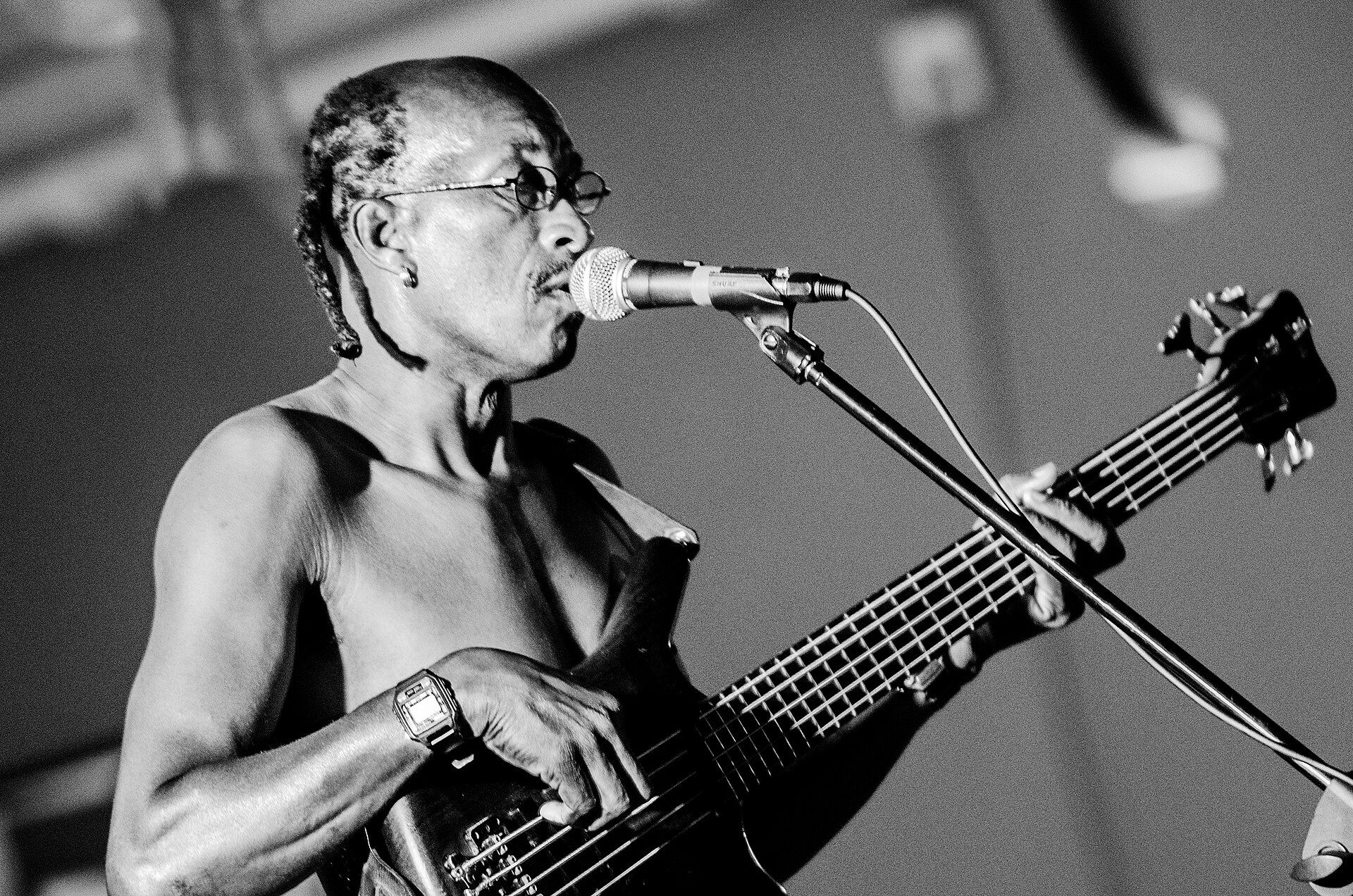 Photo of David Edwards, a member of popular soca-band, the Burning Flames. Soca Main article: soca Soca originated in the 1970s in Trinidad and Tobago .[35][36] Soca was influenced by other afro-Caribbean music styles such as reggae, calypso and salsa.[35][36] African elements present in soca include the use of percussive instruments and the tresillo beat, which is reminiscent of music from Western Africa.[3][36] This genre was also influenced by European and American music styles such as hip-hop and rhythm and blues.[36] Instruments used in soca music include Guitars, horns and percussive instruments.[35] Soca music incorporates the habanera rhythm which is of Congolese origin.[35] Mento Main article: mento Mento (also known as Jamaican calypso[37]) is a type of afro-Caribbean folk music that originated in Jamaica.[38] This genre was a precursor of other afro-Caribbean sub-genres such as ska and reggae.[39] Mento incorporates African rhythmic elements, such as the drums, with European elements, such as the guitar and the use of melodies.[3] [39][38] Like other Jamaican music genres, mento places emphasis on the after-beat.[38] Duration: 2 minutes and 27 seconds.2:27 Example of ska music: audio sample of the song "Blue Ska" by Kevin MacLeod. Ska Main article: ska Ska is a fusion genre of mento combined with rhythm and blues, that began in Jamaica in the 1950s.[39] Unlike American music, ska is defined by its emphasis on the after-beat instead of the downbeat.[38][40] This means that emphasis is placed on the second and fourth beats of the 4/4 time signature.[38] This emphasis on the after-beat is present in African rhythmic practices and mento music.[38] Ska shows European influence through the use of guitars and horn instruments.[39][3] This genre is a predecessor of another Jamaican sub-genre of afro-Caribbean music, Reggae.[38] Duration: 4 minutes and 40 seconds.4:40 Example of reggae music: audio sample of the song "Tea Roots" by Kevin MacLeod Reggae Main article: reggae Reggae is a variation of ska that emerged in the 1960s in Jamaica.[1][41] The lyrics in reggae music are closely aligned with the Rastafarian religion and focus on themes of politics and spirituality.[42] Through these lyrics, reggae has made public the issues of the poverty and inequality present in Jamaica.[43] Key Rastafarian philosophies contribute to the African influence of reggae music. These philosophies include African nationalism and a desire to live separate from European culture.[42] Duration: 3 minutes and 2 seconds.3:02 An example of merengue music. Merengue Main article: merengue Merengue is an afro-Caribbean music subgenre that originated in the Dominican Republic.[41] The Dominican merengue is a close variation of the Haitian mereng.[44] Merengue incorporates many African elements such as the use of call and response invocations, drums and guiros.[41][45] European elements that are included in merengue include use of the cuatro guitar, harmonic melodies and the accordion.[41][3] Haitian Mereng Mereng originated in Haiti as a fusion genre of traditional African music mixed with European elements.[44] The mereng is influenced by the African music genres of chica and calenda, and the European genre of contredanse.[44] |
アフロ・カリビアン・サブジャンル ソン・クバーノ 主な記事:ソン・クバーノ ソン・クバーノはキューバでバントゥー系アフロ・カリビアン人の間で生まれた[31]。ソン・クバーノはヨーロッパとアフリカの楽器と音楽要素を取り入れ ている[32]。アフリカの影響はボンゴ、コンガ、クラベスなどの打楽器の使用に見られる[32]。一方、スペインの影響はギターとハーモニック・ヴォー カルの使用によって明らかである[32]。 演奏時間 0秒0:00 サルサ音 楽の例 サルサ 主な記事:サルサ サルサは、アフリカとスペインの両方の影響を受けたアフロ・カリビアン音楽のサブジャンルである[33]。このサブジャンルは、アフロ・キューバのもう1 つの音楽ジャンルであるソン・クバーノを現代風にアレンジしたものである[34]。 [34]サルサはアフロ・カリビアン音楽のジャンルに深く根ざしているが、サルサは1960年代にニューヨークで生まれ、発展した[34]。サルサ音楽に おけるアフリカの要素には、コール・アンド・レスポンスによる呼びかけや、ボンゴやコンガ・ドラムなどのアフリカ由来の楽器の使用が含まれる[34] [3]。サルサ音楽のスペインの影響は、スペイン語の歌詞や、トレス・ギターなどのヨーロッパの楽器の使用を通して見られる。サルサにはクラーベのリズ ム、コールアンドレスポンス、シンコペーションのリズムが含まれる。 カリプソ 主な記事:カリプソ カリプソはトリニダード・トバゴで生まれたアフロ・カリビアン音楽のサブジャンルである[35]。カリプソ音楽は4分の4拍子で演奏され、シンコペーショ ンのリズムを利用する[35]。ドラム、パーカッション、コール・アンド・レスポンスによる呼びかけの使用は、カリプソ音楽におけるアフリカの影響の一例 である[35][3]。カリプソ音楽に存在するシンプルなハーモニー、アコースティック・ギター、ベース・ギターはヨーロッパの影響によるものである [35][3]。  人気ソカバンド、バーニング・フレイムスのメンバー、デヴィッド・エドワーズの写真。 ソカ 主な記事:ソカ ソカは1970年代にトリニダード・トバゴで生まれた[35][36]。ソカはレゲエ、カリプソ、サルサなどのアフロ・カリビアン音楽の影響を受けている [35][36]。ソカに存在するアフリカ的な要素には、打楽器の使用や、西アフリカの音楽を彷彿とさせるトレシージョ・ビートなどがある。 [このジャンルはヒップホップやリズム・アンド・ブルースといったヨーロッパやアメリカの音楽スタイルからも影響を受けている[36]。ソカ・ミュージッ クで使用される楽器にはギター、ホーン、打楽器などがある[35]。ソカ・ミュージックはコンゴ発祥のハバネラ・リズムを取り入れている[35]。 メント 主な記事:メント メント(ジャマイカン・カリプソとも呼ばれる[37])は、ジャマイカで生まれたアフロ・カリビアン民族音楽の一種である[38]。このジャンルはスカや レゲエなどの他のアフロ・カリビアンなサブジャンルの先駆けである[39]。メントはドラムなどのアフリカのリズム要素とギターやメロディの使用などの ヨーロッパの要素を取り入れている[3][39][38]。他のジャマイカの音楽ジャンルと同様に、メントはアフタービートを重視している[38]。 演奏時間: 2分27秒.2:27 ス カの例:Kevin MacLeodによる「Blue Ska」のオーディオサンプル。 スカ 主な記事:スカ スカは、1950年代にジャマイカで始まったメントとリズム・アンド・ブルースの融合ジャンルである[39]。アメリカ音楽とは異なり、スカはダウンビー トの代わりにアフタービートを強調することで定義される[38][40]。 これは、4/4拍子の2拍目と4拍目に重点を置くことを意味する[38][40]。 [スカはギターやホーン楽器の使用を通じてヨーロッパの影響を受けている[39][3]。このジャンルはジャマイカのアフロ・カリビアン音楽のもう1つの サブジャンルであるレゲエの前身である[38]。 演奏時間 4分40秒.4:40 レ ゲエ音楽の例:Kevin MacLeodによる「Tea Roots」のオーディオサンプル レゲエ 主な記事:レゲエ レゲエは1960年代にジャマイカで生まれたスカのバリエーションである[1][41]。レゲエ音楽の歌詞はラスタファリアンの宗教と密接に結びついてお り、政治と精神性をテーマにしている[42]。これらの歌詞を通して、レゲエはジャマイカに存在する貧困と不平等の問題を公にした[43]。これらの哲学 には、アフリカのナショナリズムやヨーロッパ文化から分離して生きたいという願望が含まれる[42]。 収録時間 3分2秒.3:02 メ レンゲ音楽の一例。 メレンゲ 主な記事:メレンゲ メレンゲはドミニカ共和国発祥のアフロ・カリビアン音楽のサブジャンルである[41]。ドミニカのメレンゲはハイチのメレンゲに近いバリエーションである [44]。メレンゲには、コール・アンド・レスポンスの呼びかけ、ドラム、ギロなどのアフリカの要素が多く取り入れられている[41][45]。メレンゲ に含まれるヨーロッパの要素には、クアトロ・ギター、ハーモニック・メロディ、アコーディオンの使用がある[41][3]。 ハイチのメレンゲ メレングは、伝統的なアフリカ音楽にヨーロッパの要素をミックスしたフュージョン・ジャンルとしてハイチで生まれた[44]。 メレングは、アフリカ音楽のチカやカレンダ、ヨーロッパのコントルダンスというジャンルの影響を受けている[44]。 |
| Caribbean music in the United
Kingdom Music of the African diaspora Music of the Bahamas Music of Barbados Music of Belize Music of Colombia Music of Cuba Music of Dominica Music of the Dominican Republic Music of Guadeloupe Music of Guyana Music of Haiti Music of Jamaica Music of Martinique Music of Montserrat Music of Panama Music of Puerto Rico Music of Suriname Music of Trinidad and Tobago Music of Venezuela |
イギリスのカリブ音楽 アフリカン・ディアスポラの音楽 バハマの音楽 バルバドスの音楽 ベリーズの音楽 コロンビアの音楽 キューバの音楽 ドミニカの音楽 ドミニカ共和国の音楽 グアドループの音楽 ガイアナの音楽 ハイチの音楽 ジャマイカの音楽 マルティニークの音楽 モンセラットの音楽 パナマの音楽 プエルトリコの音楽 スリナムの音楽 トリニダード・トバゴの音楽 ベネズエラの音楽 |
| Bibliography Leymarie, Isabelle (1993). La salsa et le Latin Jazz. Paris: PUF. ISBN 2130453171. Leymarie, Isabelle (1996). Du tango au reggae: musiques noires d'Amérique latine et des Caraïbes. Paris: Flammarion. ISBN 2082108139. Leymarie, Isabelle (1997). La música latinoaméricana: Ritmos y danzas de un continente. Barcelona: BSA. ISBN 8440677057. Leymarie, Isabelle (1998). Músicas del Caribe. Madrid: Akal. ISBN 8440677057. Leymarie, Isabelle (1998). Cuba: La Musique des dieux. Paris: Éditions du Layeur. ISBN 2911468163. Leymarie, Isabelle (2002). Cuban Fire: The Story of Salsa and Latin Jazz. New York: Continuum. ISBN 0826455867. Leymarie, Isabelle (2003). La Música cubana: Cuba. Barcelona: Océano. ISBN 8449424097. Leymarie, Isabelle (2003) [1998]. Dizzy Gillespie. Paris: Vade Retro, Buchet Chastel. ISBN 2909828735. Leymarie, Isabelle (2005). Jazz Latino. Barcelona: Robinbook. ISBN 8496222276. |
|
| https://en.wikipedia.org/wiki/Afro-Caribbean_music |
|
リ ンク
文 献
そ の他の情報
Copyleft, CC, Mitzub'ixi Quq Chi'j, 1996-2099
☆
 ☆
☆